A Study on Golf Swing
A Study on Golf Swing:
Rationality of Human Body Structure
(Japan Journal of Golf Sciences 2000, 13, 3, 57-64)
HISASHI MURATA
community leader. Shinagawa clinic orthopedic surgery
Abstract
In this study, an attempt is made to seek implications of physical movements of human body observed in golf swings for the study of the structure of human body from the point of a practicing specialist in the field of orthopedic surgery. Following general points have been induced as commonly observed rational patterns of physical behavior from the static as well as dynamic analysis of body movements seen in golf swings of many professional and amateur players under the analytical framework of kinematical approach.
(1)The orthodox swing always consists of rational and natural body movements.
(2)Grips: Forms of grips must be consistent with the natural rotational movements of forearms (the principles of the prosupinations of forearms).
(3) The posture and stance: Firm positioning of the center of gravity is the key to stable golf swing.
(4)Putting: A perpendicular swing plane is possible. The rotary turn of the shoulder joints on both sides,which is made possible by the pendulum movement from the both shoulder joints to a club head around horizontal axis of the swing center, forms the basic motion of any swing from a chip shot to a driving shot from the tee.
(5)Full swing: In the upper part of the body, a twisting turn around the spinal column dominates while in the lower half of the body, the basic motion consists of the shift of the body weight from the right hip joint to the left. The entire swing motion is full of bouncing vigor.
Key words:
The orthodox swing, address, center of gravity, making the swing center axial ,changing the human body to the spring
Knowledge to be necessary for swing analysis is physics, anatomy, physiology or psychology, in particular, approach from the dynamics and body structure studies is important. It is the secret to become good at sports that to adapt physical structure for function. Golf is sports a body moves for a ball standing still, therefore it is well suited for movement analysis.
PURPOSES
I analyzed a lot of static and dynamic images of swing of professional and amateur golfers. I observed “how the joint and the skeleton of physical various part moved.” And, from the viewpoint of characteristics of a joint, I tried elucidation of own simple following question.
1)Relationship between grips and trajectories. A function of muscles and skeletons, in particular from connection with forearm rotation.
2)An ideal address in physical posture and balance.
3)Swing plane in putting. When a club head forms a swing arc, where in the human body is the swing center that is the center of the motion?
4)Relationship between twisting motion (coiling) of upper part of the body or lower part of the body and structure of the human body. A position of swing axis. Relationship between swing axis and spinal column. How do both shoulder joints move around the axis?
5)Movement of cocking.
METHODS
I estimated each joint center about hand joint, elbow joint, shoulder joint, spinal column, pelvis, hip joint, knee joint, ankle joint, foot part, and marked it. I observed motions of joints and skeletons and extracted the things of the greatest common divisor. I considered what is the reasonable movement of the masters who applied a characteristic of joints and skeletons of body everywhere.
cf.Fig.1
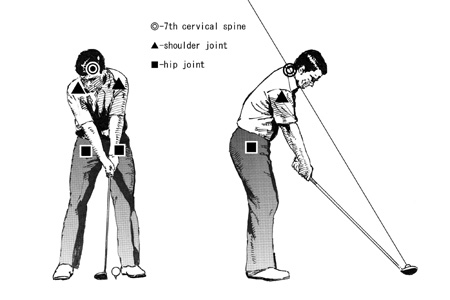
Fig.1
1.GRIPS AND SHAPING OF SHOT cf.Fig.2 Fig.3
Some attention points of relationship between grips and shaping of shot were seen from the function of the wrist joint, the elbow joint and the forearm, as follows.
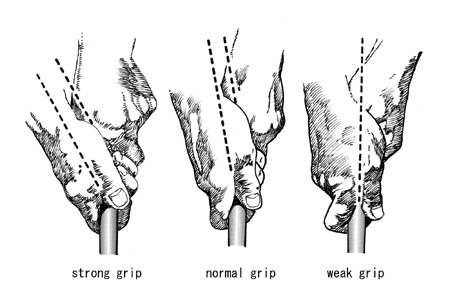
Fig.2
1)It becomes easier to use forearm rotation in order of weak grip, normal grip and strong grip, and is apt to hit strong draw ball. Ikegami says ; “Keeping a little of angle of cock until a moment before an impact is a method to get the maximum head speed at the time of impact and to extend carry.” Forearm rotation is the important skill that you should master in order to achieve this purpose.
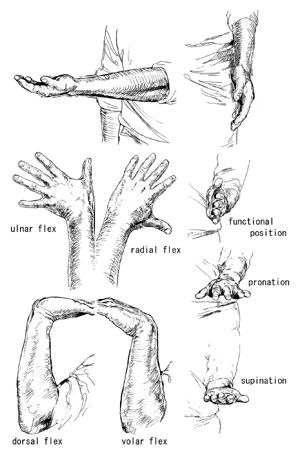
Fig.3
2)As for weak grip, it is apt to cock in almost radial side of a left wrist joint. And as for normal grip and strong grip, it is apt to cock in radio-dorsal side of a left wrist joint.
Judging from a range of movement of a joint, normal grip and strong grip are with cock more deeply.
3)Excessive strong grip is easy to hit a strong ball, but is apt to hit a ball with to much over spin.
4)Most of the persons who grasped a golf club for the first time pick up the right thumb on a shaft on the straight and are going to beat a ball strongly. This is wrong recognition of swing. The grip is an only part connecting a tool with a person.
The too much firm grip is not useful.
2.ADDRESS
1)Fig.4 shows that a center of gravity is located at most center of both feet in the sagittal plane and frontal plane for each shot.
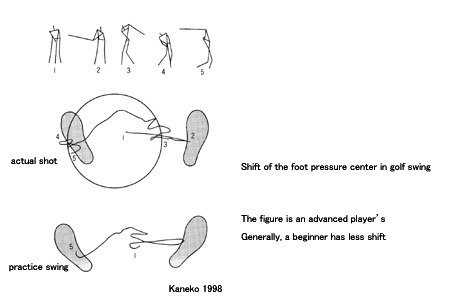
Fig.4
2)Fig.5, 6 indicate an address from the front. The figures show that a phenomenon of deviating to a right foot of a center of gravity because the spinal column inclines right can be revised by shifting a position of a waist to the left foot side a little.
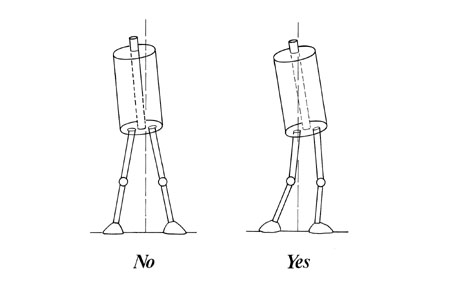
Fig.5
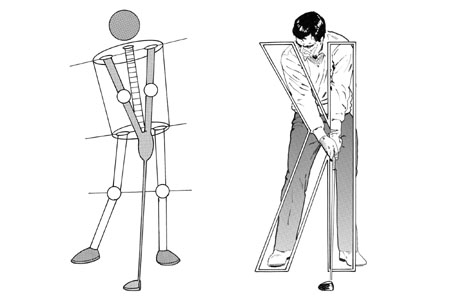
Fig.6
3)Fig.7, 8 show that semi sitting posture of pushing out a waist aback a little hangs down a center of gravity of front and back to a line of the arch of a foot when they posture to bend forward. In case of doll, two of the left have fallen down. A tip for making this posture, is not bending both knees to the front and keeping legs straight vertically.
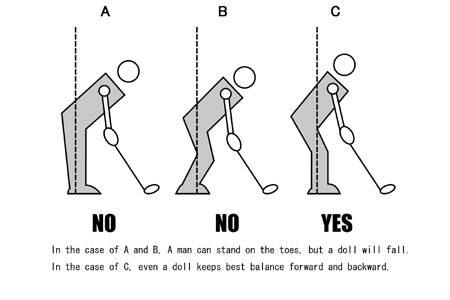
Fig.7
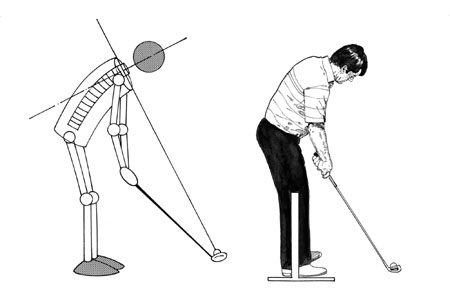
Fig.8
4)Well-balanced address enables stable twisting motion of the entire body at full swing. This thing is indispensable.
3. SWING PLANE IN PUTTING
Putting is a basis of swing. Before discussing swing, you must understand the swing plane that Ben Hogan first submitted as a general idea.
cf.Fig9
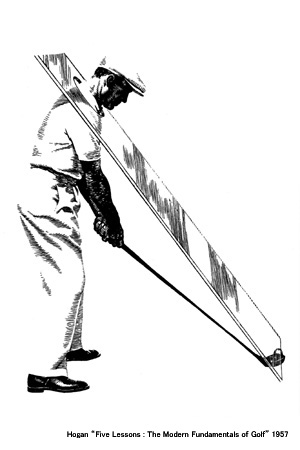
Fig.9
Swing plane is a plane like a glass board. It is formed by the neighborhood of the seventh cervical vertebra that is the center point around which both shoulders principally rotate and the club head which has a role of hitting a ball.
It is a point of simple and ideal swing that a trace of a club head (a swing arc) is not off the swing plane.
This swing plane is different by height of players and length of a club. A tall person comparatively forms upright swing plane, a short person comparatively forms flat swing plane.
I show a interesting matter here. The swing center (seventh cervical vertebra) is set up in a right angle for swing plane. This is common to professionals called master. I think that both shoulder joints can rotate naturally for swing plane. I suppose that Al Geiberger called Mister 59 holds round back as an occupational disease even in a normal walk for his tall height. He must take such posture unconsciously. It is important to be conscious of the lowest point of swing arc namely swing bottom in order to let a club head work efficiently.
I observe putting form in consideration of the things described until now.
cf.Fig.10 Fig11
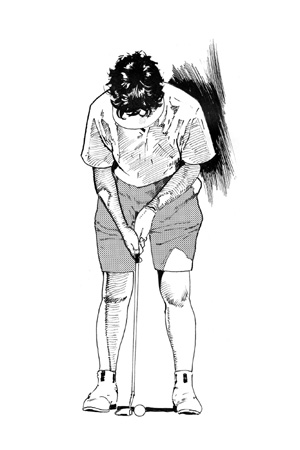
Fig.10
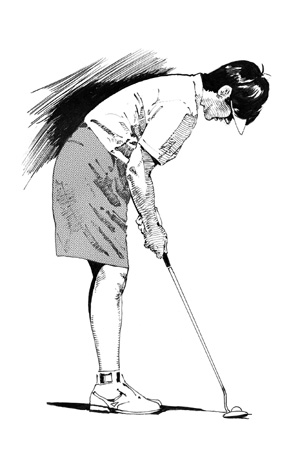
Fig.11
I tried to make a putting model of fig.12 on the basis of these illustrations.
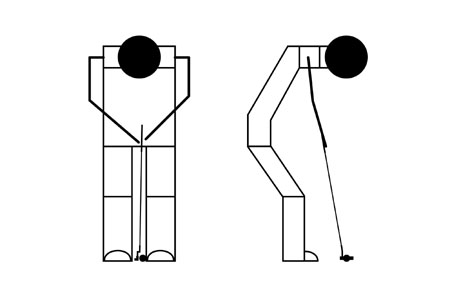
Fig.12
It is said to putting that there is no fixed form. . For money-making, players adopting a unique form are not a little. However, a putting form to have meaning as a basis of swing which I have described heretofore is the most popular, isn’t it? I enumerate the characteristic as follows.
1)Keeping the posture highly as far as possible. This is important in order to bear an exercise of long time, and to prevent lumbago.
2)Both eyes are located in a ball and a target line.
3)By keeping cervical vertebrae horizontally, the swing center changes into horizontal axis, and then the swing plane is able to become completely plumb. Fig.13 shows the skeletal connection to the shoulder joints which are the roots of the arms through the ribs, the clavicles, the scapulae from cervical and upper thoracic spine. Orbit of a putter head becomes straight to straight theoretically by keeping pendulum motion not to break a pentagon or triangular form. Both elbows have to be kept a little away from a body so that they are not influenced by torsion of a body.
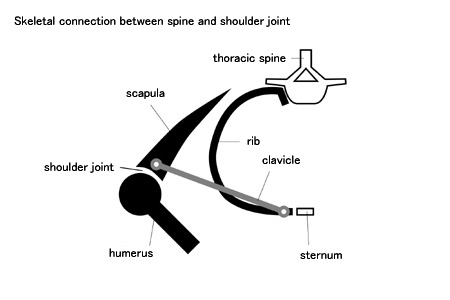
Fig.13
4)A swing bottom is located under the brow. Hitting point becomes mostly near this position.
5)Hand first a little because the loft of a putter is about 4 degrees.
4. FULL SWING
Finally I consider full swing that aims at Far and Sure.
About a matter described as follows, see the next continuous photograph illustration.
cf.Fig.14
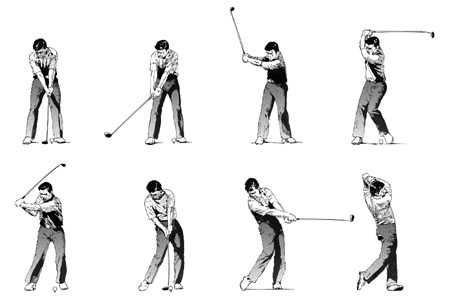
Fig.14
1)About coiling of the human body. The upper part of the body can be suitable for twisting motion centering around the spinal column generally. However, the lower part of the body is the structure that is not suitable at all for coiling. It is the pelvis that connects two these heterogeneous structures. There are two structures which can twist namely hip joints in the pelvis. Mr. Watarai described “, It is considered that a burden comes to lumbar vertebrae, when a turn of the pelvis on the hip joint is not harmonized and is not full in swing. ” Furthermore, Mr. Sakuraoka writes down, “In advanced players the twisting motion occurs mainly around the spinal column by early stage of back swing, then the center of turn moves a right hip joint.” “Movement of a waist of advanced players turns mainly on the right leg in early stage of forward swing, and it moves by degrees to the left, and the left leg becomes the center of turn in an impact.” It is expressed with “the transverse movement of the hip” in The search for the PERFECT SWING. I supposed about coiling of the whole body, in take back, twisting motion is done between the swing center i.e. seventh cervical vertebra and the right hip joint as the fulcrum, when the left hip joint returns to the position in the address on the way of downswing, uncoiling is done with the swing center and the left hip joint this time as the fulcrum. Fig.15 showed movement of the pelvis in swing. I thought one spindle theory i.e. the spinal column formerly about twisting motion of the whole body but judging from the joint function I came to think that it was unnatural. The discontinuous movement that the fulcrum changes from the right hip joint into the left hip joint is the most difficult part in swing. Will not it be for this purpose that slow rhythm in downswing is emphasized?
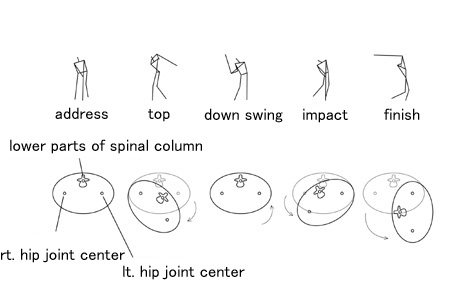
Fig.15
2)A swing image by feeling that is “to apply centrifugal force” “to feel heaviness of a club head” “to add reaction” is extremely important in order to raise a spring effect. According to Mr. Kaneko, reaction movement draws nature as a spring of a muscle. It will be just like application of this dynamic characteristic. I would like for you to remember toss or throwing of baseball.
cf.Fig.16 Fig.17
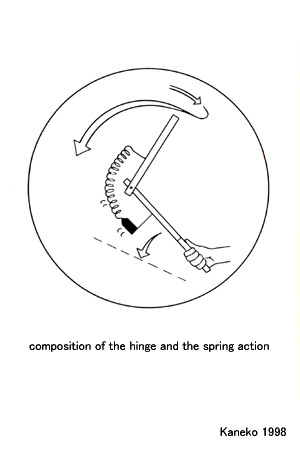
Fig.16
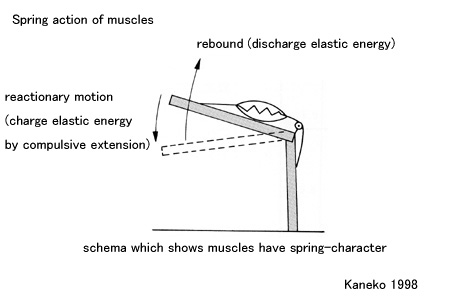
Fig.17
It is written in The search for the PERFECT SWING that during continuous movement of swing, development of a system must not include looseness. This is the important skill that master should acquire. I think that 3rd and 4th frame of the continuous photograph can draw this feeling up.
3)The players should swing while imaging that the movement of a club head having a duty to hit a ball is on plane. I want you to pay attention to how shoulder turn or cocking should be done in order to achieve this major premise. I think that a way of thinking is apt to become contrary. It is fig.18 that viewed swing plane nearly from a right angle direction (the side of diagonally upper front). When I take back with a fixed lever arm around the swing center, then a left shoulder joint moves from C to C’ and also A or B ought to go out of the swing plane in the same way. Textbooks emphasize “ let a club head start straight from A to A’.” It is because cocking done inconsiderably puts a club head on the swing plane.
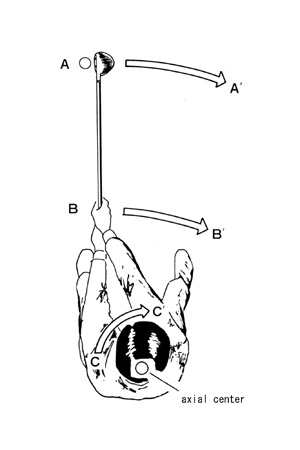
Fig.18
5. MECHANISM OF COCKING cf.Fig.19
Cocking is compound motion that a left wrist joint bends to radio-dorsal side and a left shoulder joint direction, and the right forearm does inward rotation simultaneously, and a right elbow joint bends. Reproductiveness of body turn swing rises by keeping a formed isosceles triangle with both shoulders joint in an address and a grip.
Fig.20 showed position relationship with a ball and iron, fairway wood, driver. The position of the grip is positioned in the left thigh part inside in all addresses, and it is done the address which a swing bottom comes to beneath. It shows those set ups make the iron can stroke down blow, the fairway wood can stroke side blow, the driver can stroke upper blow.
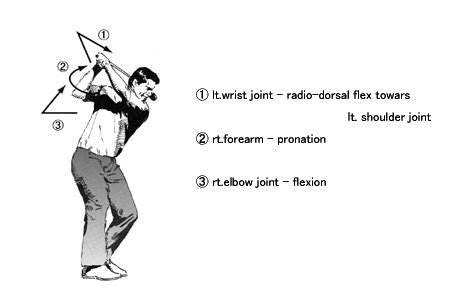
Fig.19
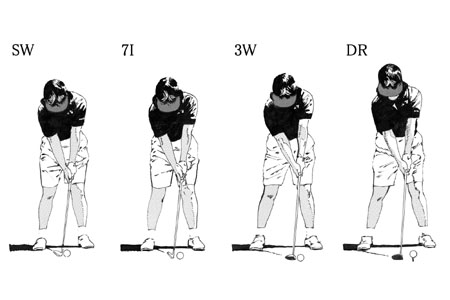
Fig.20
CONCLUSION
1)GRIP : By connection with forearm rotation (inward/outward rotation of a forearm).
2)ADDRESS : Importance of a center of gravity. Positioning of hips. Slightly deflection to a left foot direction and semi sitting. Stable swing becoming possible.
3)PUTTING : By making the swing center a horizontal axis, in other words, by maintaining horizontal from the upper part of thoracic vertebra to cervical vertebrae, the head, the part from a both shoulders joint to a club head vertical pendulum motion. Turn motion of this both shoulders joint becomes basic motion of swing from a chip shot to a driver.
4)FULL SWING : To grind the whole body like a spring. The upper part of body does twisting motion around the spinal column. As for the lower part of the body, weight movement from the right hip joint to the left hip joint is the subject. A swing axis is a 2 axis.
5)MECHANISM OF COCK : Cock of a normal grip is regarded as compound motion. A left hand joint is radio-dorsal flex in a left shoulder joint direction, the right forearm is pronation, a right elbow joint is flex.
With the above I described an outline of way of thinking for my swing, but there are a few appropriate illustrations and reflects seriously by explanation lack. Judgment from the appearance by image analysis || of motion || decline not to be able to read it until the time with saying that intend.
In addition, it is a one personal opinion, and a theory of this hypothesis should , so to say, claim to be even my study report strictly.
In particular it is not exceeded a level of guess about a dynamic historical investigation. By some means, I will want to make it clear in future.
References
1)Hisako Ikegami:Relationship of the arm and the club in golf swing, Jap. J. Golf Sciences, 3:00 62, 1999
2)Masahiro Kaneko:Sports biomechanics guide, Kyourin-syoin, 66,46-47, 1998
3)Kazuaki Kawashima:The study of biomechanics of golf swing, Jap.J. Golf Sciences, 1:34-40, 1987
4)Ben Hogan:Modern golf, baseball magazine company. 78-80, 1998
5)J.Castaing, J.J.Santini:Function dissection – front legs / spinal column of joint / exercise device, Kyoudou-isyo-syuppansya, 5,1986
6)Kimiharu Watarai:About golf and movement of lumbar vertebrae, Jap.J. Golf Sciences2:42-44,1990
7)Hiroshi Asaoka:Torsion of a human trunk in swing movement of golf, Biomechanics of body exercise, No. 13 Japan biomechanics society, 324-329,1997
8)How Muscles Work in Golf, Chapter 13, 2-7, The search for the PERFECT SWING (Japanese), Studio ship, 1991
9)Hisashi Murata:Choice. 84-1, Thinking about the usage of joints, Golf digest company, 59-65,1984
10)Hisashi Murata:The reasonable golf swing that I analyzed from body structure, Asahi Golf, Kousaido-sanpo-syuppan, PART7.107-110. June1985

